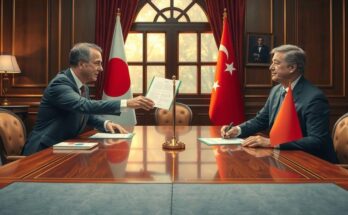On March 8, four Iranian men engaged in an armed standoff against security forces, illustrating heightened tensions between dissidents and the Islamic Republic. Abol Korkor tragically ended his life during the confrontation, while his compatriots faced serious repercussions. This event signifies a potential shift towards nationalistic rebellion and increased public discontent with the regime, as surveys indicate overwhelming dissatisfaction among Iranians.
On March 8, a group of four Iranian men engaged in an armed standoff against security forces, an event broadcast live on Instagram. The incident highlighted the tensions between dissidents and the Islamic Republic, with gunfire and tear gas seen engulfing the location where the men had taken refuge. In a poignant moment, one rebel, Abol Korkor, delivered his farewell words—”I have no other choice, goodbye, Iran”—before taking his own life, symbolizing the desperation faced by opposition members in Iran.
The remaining dissidents included Sohrab Ahmadi, Hossein Mehri, and Reza Abdollahzadeh. Footage from the regime’s Fars News showed Mehri and Abdollahzadeh hospitalized following the clash, while Ahmadi was notably absent, raising concerns about his fate. Sources suggest he may have been either killed during the incident or apprehended by authorities.
Historically, the Iranian regime has been known for extracting forced confessions from political prisoners, branding them as foreign agents. In this case, authorities released a video depicting Korkor as a criminal, attempting to delegitimize the group’s motives. The nationalists had previously organized significant anti-regime protests, with Korkor being pursued by security forces since the uprisings of 2022.
Reports indicated the regime deployed additional forces to Izeh post-clash and imposed internet restrictions, standard measures during civil unrest. Notably, the group’s nationalist agenda differentiates this incident from previous clashes often driven by sectarian separatist motives. Korkor had exhibited nationalistic sentiments, displaying the pre-revolutionary Iranian flag and boldly rejected the regime during the standoff.
The armed rebellion signifies a potential shift in the character of opposition in Iran, moving from reformist demands to overt acts of rebellion against the regime. Recent trends in polling illustrate widespread dissatisfaction among Iranians, with an alarming 92% expressing discontent regarding the country’s current conditions, according to a regime-conducted survey. This evolution in public sentiment suggests that some dissidents are embracing more aggressive tactics as a response to the overwhelming repression experienced under the Islamic Republic.
The armed standoff involving Korkor and his compatriots represents a poignant turning point in Iran’s ongoing struggle against the Islamic Republic. As public outrage mounts, there is a noticeable shift toward nationalism and acts of resistance that venture beyond mere demonstrations, indicating a deep-rooted desire for revolution and significant change among the Iranian populace. The regime’s historical repression may have catalyzed this transformation, compelling dissidents to adopt more radical approaches in their fight for freedom and justice.
Original Source: www.longwarjournal.org




